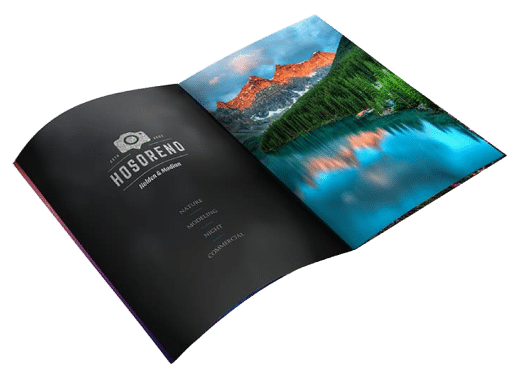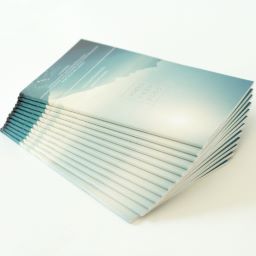The Pros and Cons of Digital vs. Offset Booklet Printing
The Pros and Cons of Digital vs. Offset Booklet Printing
Blog Article
The Crucial Overview to Understanding Brochure Printing Options and Techniques
The procedure of booklet printing includes several factors to consider that can significantly affect the end product. From selecting the appropriate style and dimension to comprehending the nuances of binding methods, each option plays an essential role. Additionally, variables such as paper supply and printing techniques further influence the performance of the brochure. As one navigates these alternatives, it ends up being essential to comprehend exactly how they adjoin and what that means for the total outcome.
Understanding Brochure Sizes and layouts
When thinking about booklet printing, recognizing the numerous formats and sizes readily available is crucial for accomplishing the wanted presentation. Pamphlets can be created in numerous styles, including saddle-stitched, spiral-bound, and perfect-bound, each offering unique advantages. Usual sizes vary from standard letter (8.5 x 11 inches) to smaller sized options like A5 (5.8 x 8.3 inches), allowing for versatility based upon content and target audience.Selecting the ideal size can affect both the layout and viewers involvement. Larger dimensions could suit aesthetically driven content, while smaller sized layouts might be a lot more mobile and straightforward. Furthermore, the variety of pages affects the choice of binding technique, as thicker brochures might need stronger bindings. Ultimately, comprehending these facets permits for a much more customized strategy, making certain that the last item straightens with the desired message and aesthetic, enhancing the general effectiveness of the interaction.
Picking the Right Paper Stock

Binding Approaches: Choices and Considerations
When it involves binding techniques for brochures, a number of options are offered, each with distinctive benefits. Saddle stitch binding offers a cost-efficient solution for thinner brochures, while ideal binding methods give a more refined search for thicker publications. Wire-O binding stands out for its toughness and convenience of use, making it excellent for papers that call for versatility.
Saddle Stitch Binding
Saddle stitch binding uses a useful and economical solution for assembling brochures, making it a popular choice among authors and businesses. This binding method involves folding sheets of paper in half and stapling them along the fold line, producing a orderly and neat look. Normally appropriate for brochures with a lower web page matter, saddle sewing is perfect for publications, brochures, and training products. The simpleness of this strategy permits quick production and is frequently preferred for brief runs or promotional products. It is crucial to keep in mind that saddle stitch binding may not be ideal for thicker pamphlets, as the spine may not hold up under enhanced weight. In general, it stays a reliable alternative for many printing jobs.
Perfect Binding Techniques
Perfect binding is a widely made use of technique that offers a polished and specialist finish to magazines and booklets. This method entails gluing the pages with each other at the spine using a strong adhesive, enabling a tidy edge and the capacity to hold a bigger variety of web pages compared to saddle stitching. Perfect binding is especially appropriate for thicker brochures, such as directories and annual records, where a sturdy, level spine is desired. In addition, it offers the choice for a published cover that can be developed to boost visual charm. Considerations such as web page matter, paper weight, and the meant use of the pamphlet ought to be taken into account, as they can influence resilience and overall high quality.
Wire-O Binding Alternatives
Wire-O binding, recognized for its resilience and versatility, uses an exceptional alternative for brochures that require easy web page turning and an expert appearance. This binding method utilizes a collection of metal loops that hold pages securely, permitting them to exist level when open. It is especially ideal for presentations, guidebooks, and magazines because of its robust nature. Wire-O binding is available in various colors and sizes, fitting various page matters and thicknesses. Furthermore, it permits the inclusion of covers and tabs, boosting the brochure's overall visual. Factors to consider for Wire-O binding consist of the choice of cable shade, the dimension of the loops, and the degree of customization desired, every one of which can profoundly influence the end product's look and capability.
Digital vs. Offset Printing: Which Is Best for You?
When selecting a printing method for pamphlets, recognizing the differences between electronic and offset printing is essential. Digital printing uses contemporary technology to produce premium prints promptly and affordably, making it suitable for brief runs or projects needing quick turnaround times. It permits for modification, giving the capacity to print on-demand with very little waste.In contrast, counter printing is a typical technique that masters producing huge quantities with regular top quality. It includes moving ink from a plate to a rubber blanket, then to the paper, which leads to dynamic colors and accurate information. Nevertheless, balance out printing typically requires longer setup times and is more affordable for larger volumes.Ultimately, the choice between electronic and offset printing depends on project click reference needs, spending plan, and desired quantity. For little, time-sensitive projects, electronic could be the ideal option, while countered might be preferable for bigger, top notch manufacturings.

Designing Your Booklet: Tips and Finest Practices
When designing a brochure, mindful attention to layout, font choice, and shade usage can significantly improve its effectiveness. A well-structured design guides the viewers's eye, while appropriate typefaces guarantee readability and communicate the desired tone. In addition, effective use shade can evoke emotions and emphasize key information, making the overall layout extra impactful.
Selecting the Right Design
How can one properly choose the ideal design for a pamphlet? First, it is vital to assess the booklet's objective and target audience. A clean, arranged design enhances readability and involvement. Utilizing a grid system can help in aligning components regularly, developing an expert look. In addition, integrating aesthetic pecking order via varying dimensions and positionings of photos and text can lead the reader's eye and highlight key info. It is likewise important to leave sufficient white area, which prevents overcrowding and enables much better focus. Checking different layouts with mock-ups can supply understanding right into how the layout performs in real-world situations, making certain that the last item fulfills both practical and aesthetic demands. Useful Selecting Proper Typefaces
An appropriate font can greatly enhance the overall style of a brochure, enhancing the design and enhancing the web content's message. The option of fonts should consider readability, especially for body text, as it guarantees the details is easily accessible to all viewers. Sans-serif typefaces are usually favored for electronic styles, while serif font styles can Your Domain Name offer a conventional feel in published materials. It's advisable to restrict font selections to 2 or three to maintain aesthetic comprehensibility. Furthermore, font style size plays an important duty; headings must be unique yet not frustrating, while body text ought to be comfortable for analysis. When choosing fonts, alignment with the brochure's motif and target audience is vital for efficient communication and aesthetic allure.
Effective Use Color
Shade acts as an effective tool in booklet layout, leading and forming assumptions visitor emotions. It can stimulate feelings of peace, trust, or enjoyment, depending on the colors picked. Designers ought to take into consideration shade concept concepts, guaranteeing that the selected scheme aligns with the brochure's message and target audience. For instance, utilizing cozy shades like red and orange can create urgency, while cooler tones like blue and green foster tranquility.Additionally, comparison plays a vital function; corresponding shades can boost readability and aesthetic allure. Uniformity in shade use throughout web pages additionally reinforces brand identity and cohesion. Ultimately, effective color implementation not only catches interest however likewise strengthens the brochure's function, making it a necessary facet of successful design.
Finishing Touches: Coatings and Unique Effects
While numerous think about the content and layout of a pamphlet one of the most important components, the ending up touches, such as finishes and unique impacts, play a vital function in improving its overall allure. Coatings can give security and toughness, making sure that the booklet withstands damage. Matte surfaces provide a sophisticated, non-reflective surface area, while glossy coatings can make shades appear even more vibrant and attractive. Special results, like embossing or foil marking, include a tactile measurement that can produce a memorable impact. These methods can highlight specific locations, drawing focus to crucial details or developing visual passion. Additionally, UV coating can offer a high-shine finish that raises the total look.Together, these completing touches not just improve the pamphlet's visual however additionally interact professionalism and reliability and focus to detail, eventually leaving a long-term influence on the visitor.
Expense Factors To Consider for Booklet Printing
Understanding the numerous expense factors to consider for booklet printing is crucial for companies and companies intending to optimize their budget plans. Trick factors influencing expenses consist of the choice of ink, paper, and binding approaches. Better materials, such as exceptional paper or specialized inks, usually enhance the general cost. In addition, the dimension and page count of the brochure play a substantial duty; bigger booklets call for more resources and time to produce.Another essential consideration is the printing method, whether electronic or balanced out, as each has its very own rates framework and viability for various amounts. Organizations need to additionally consider layout prices, which can differ based upon intricacy and the usage of professional services. Eventually, shipping and handling fees can contribute to the total, especially for big orders. By reviewing these components, companies can make enlightened choices that line up with their monetary capabilities while achieving the desired top quality in their published products.
Often Asked Questions
What Are the Environmental Effects of Brochure Printing?
The environmental impacts of pamphlet printing consist of deforestation from paper production, carbon emissions from transport, and waste generation from disposed of materials - Booklet Printing. Sustainable techniques, such as utilizing recycled paper and environmentally friendly inks, can reduce these effects
Just How Can I Make Sure Color Precision in My Pamphlet?
To ensure color precision in a brochure, one ought to utilize adjusted monitors, use specialist color accounts, perform examination prints, and select top quality printing services that supply find more info color matching and proofing options for ideal results.
What Is the Regular Turnaround Time for Pamphlet Printing?
The normal turnaround time for pamphlet printing varies relying on the complexity and quantity - Booklet Printing. Generally, it varies from a few days to 2 weeks, influenced by variables such as printing approaches and ending up requirements
Exist Minimum Order Quantities for Booklet Printing?

Can I Publish Brochures in Numerous Languages?
Publishing booklets in multiple languages is possible. Numerous printing services provide alternatives for multilingual or multilingual formats, enabling efficient communication. Careful planning guarantees that develop aspects fit different languages without jeopardizing readability or aesthetics. In addition, factors such as paper stock and printing techniques further affect the performance of the pamphlet. When taking into consideration pamphlet printing, understanding the numerous layouts and dimensions readily available is crucial for attaining the wanted discussion. When choosing a printing approach for booklets, recognizing the distinctions in between digital and balance out printing is important. Furthermore, the size and page matter of the pamphlet play a substantial duty; larger booklets require even more resources and time to produce.Another essential consideration is the printing technique, whether electronic or balanced out, as each has its own rates framework and suitability for various amounts. The environmental influences of brochure printing include logging from paper manufacturing, carbon exhausts from transport, and waste generation from disposed of products.
Report this page